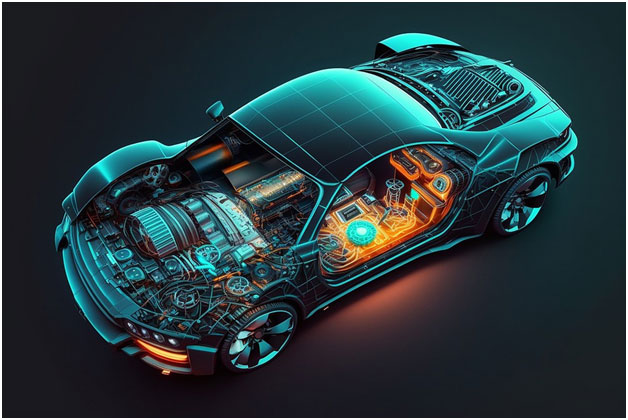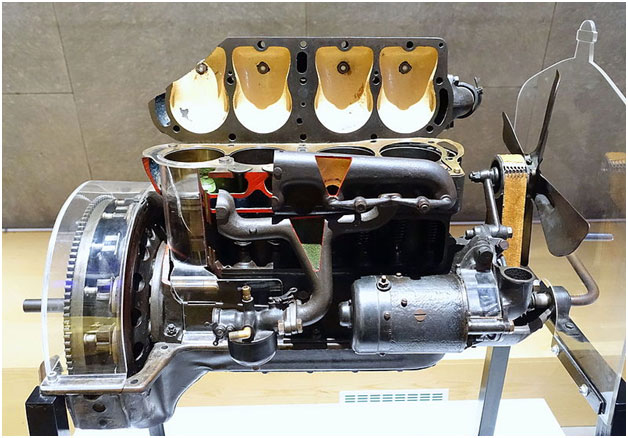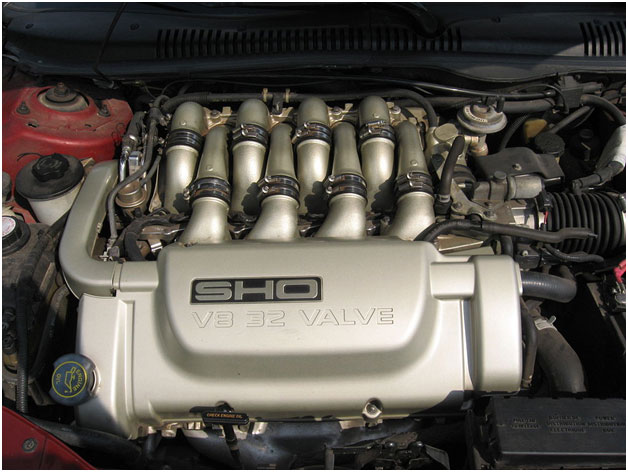
Image Credit: Gidon Pico from Pixabay
Cars have transformed our ability to get from place to place safely and efficiently while also in our own time. Given many developments in the past century, the automobile has also changed a lot to ensure that vehicles are even safer and have fewer impacts on the environment. We will discuss many innovations that went into making the average automobile a key to private transportation, ranging from the invention of the gasoline engine and the seat belt to the creation of the fuel injector and modern full autonomous vehicles. The automobile is one of the most important inventions of its time thanks to the amount of effort and knowledge put into making them safer and more reliable.
Early Automobile Innovations

Model T automobile engine image by Daderot, CC0, via Wikimedia Commons
The invention of the automobile engine
The automobile’s gasoline-powered engine might go back further than you think. The first contraption resembling an engine was built in France in 1806 and was called the Pyreolophore. While the prototype was a brilliant idea, it had issues with maintaining combustion in part because fuels at the time were coal and gunpowder based. 80 years later, Carl Benz of what you’ll know as the Mercedes-Benz. Around the same time, Nicklaus Otto developed and invented a commercially successful engine known as the Otto engine.
Introduction of the electric ignition
The electric ignition as we know it today was invented by Charles Kettering in 1904. The significant difference in development was that many engines prior to electric ignition required rotating a crank to start the engine and make fuel flow initially. Kettering’s development used coils to jump-start the engine and the starter motor at the same time. The new ignition system became a near-standard development within about 15 years of its patent and changed the physical difficulty of starting a vehicle.
Creation of the Differential
The differential came about rather early in the life of the automobile. OnésiphorePecqueur invented the necessary parts in 1827 when the vehicle itself was quite young. The purpose of the original differential was to allow the engine to more efficiently transmit power to the wheels in an equal manner until the vehicle turns, after which the gears rotate in a manner that allows the wheels to turn at different speeds. Pecqueur’s invention made vehicles much easier to drive - and made learning them easier too.
Implementation of the gear system
There were multiple attempts to develop what amounts to a modern gearbox or transmission that allows a vehicle to travel at a higher rate of speed while maintaining lower revolutions per minute. Alfred Horner Munro of Canada developed the first near-functional transmission system after many others before him had failed. José Braz Araripe and Fernando Lehly Lemos of Brazil would come up with the concept of hydraulic pressure to allow a vehicle to shift. General Motors also developed its own transmission, starting in 1932, which become popular in their vehicles in the 1940s.
Advancements in Safety Features
Introduction of Seat Belts
The creation of the seat belt comes into the automobile timeline later than you might think. Volvo is known for making safe vehicles, and inventor Nils Bohlin from Volvo would be the first to develop a buckle system in 1959 that prevented a passenger or driver from being thrown around the vehicle in the event of a sudden hard stop or accident. Volvo was also more than considerate in its development of the simple seat belt and left the patent open so that other manufacturers could use it immediately.
Development of Airbags
The airbag has a bit of a timeline in itself, as it wasn’t immediately seen as practical for a vehicle. John W. Hetrick filed an airbag patent in 1952 - notably before the inclusion of seat belts in cars. The airbag wasn’t actively included in vehicles until 1973 when the Oldsmobile Toronado (yes, there is an extra O in there on purpose) implemented the idea. Airbags simply detected an impact and released pressurized air into a bag that attempted to expand and fill the cabin before the driver or passengers had moved. At first, airbags were optional and manufacturers lobbied against requiring them because they felt drivers didn’t care. Airbags didn’t become law until 1998, which is surprisingly late though many manufacturers were installing them anyway.
Introduction of Anti-Lock Braking systems
Mario Palazzetti developed the anti-lock braking system in the early 1970s and literally earned the nickname “Mr. ABS” as a result. The anti-lock braking system was developed by Palazzetti within the FIAT Research Center and was called Antiskid, which pretty adequately describes what brakes do when they lock up. Bosch bought the idea and renamed it ABS. As you might know, ABS involves what could be described as braking force regulation - in other words, ABS ensures that you don’t push the brakes too hard and have them lock up. Instead, a motor repeatedly allows the brakes to tap automatically to prevent you from sliding because the brake is locked to the axle.
Creation of Traction Control
Traction Control as we know it today came from a Mercedes-Benz engineer Frank Werner-Mohn who found himself in a ditch in the middle of nowhere on a freezing day prior to the invention of cell phones. Werner-Mohn went on to develop an electronic system capable of transferring power between wheels based on which wheel had resistance or traction. The system allowed onboard communications to occur between the ABS and separate systems that could control the speed of wheels in a split second after traction was lost.
Evolution of Engine Technology

Image by: Exhilaration157 at English Wikipedia, Public domain, via Wikimedia Commons
Development of the Overhead Cam Shaft
Prior to the development of the overhead camshaft, which we’ll call OCS, automobile engines could be OHVs or overhead valves. An OHV is known to many as a pushrod engine and is more commonly used on motorcycles. While the OHV is a simple engine that is easy to care for, it also can’t make a larger vehicle accelerate all that fast. The OCS and DOCS(stands for Dual Overhead Cam Shaft) engines were more complicated and had a timing belt, but also produced more power and even better fuel economy. OHV engines are known as old-school engines, and honestly, we think they look cooler.
Creation of the turbocharger
The turbocharger isn’t really new in automotive technology, but it has also been underutilized because not everyone needs one! The first turbochargers were actually made for boats but were later implemented in vehicles in the 1960s, starting with the Chevy Corvair and the Oldsmobile F-85 Jetfire.
Turbochargers work on the simple process that combustion can happen faster and with more power when more air is compressed and introduced to the combustion chambers. Turbochargers basically use fans to take more air in, compress it, and send it along. Many vehicles now use smaller turbochargers to increase their low-end torque and improve fuel economy compared to traditional engines.
Introduction of the fuel injector
While the concept of a fuel injector dates back to the 19th century, they were first truly used in vehicles starting in the late 1950s - though even then they weren’t all that common. Fuel injectors didn’t become especially popular until the 1980s, when Bendix, which became part of Honeywell, introduced a system that was reliable enough to use in vehicles. Fuel injectors helped change the game a bit in starting and accelerating with vehicles, as computerized systems could inject exactly the right amount of fuel at exactly the right time instead of relying on a carburetor and a tube to inject a fuel mixture into the combustion chamber.
The fuel injector is made for more even acceleration and better gas mileage in vehicles, in addition to more reliable starting. Ever tried to start an old vehicle with a carburetor in the cold? Good luck!
Creation of the hybrid engine
Hybrid engines go back way further than you think - Ferdinand Porsche, of course of Porsche. The original electric and gas combo he designed in 1898 could go up to 35 kilometers per hour and travel 80 kilometers. Today’s hybrid engines run on the same principles - an electric battery that can run the wheels and electronics within the car, backing up with is typically a fairly smallgasoline-powered engine much like the early Prius. Much of the purpose of the hybrid engine was to reduce carbon dioxide emissions by using less fuel - and hybrid models got great gas mileage and were quite aerodynamic.
The first modern hybrid available in the United States was the Toyota Prius, released in July of 2000.
Advancements in Autonomous Driving
Introduction of Adaptive Cruise Control
Adaptive Cruise Control uses a camera or radar on the front of the vehicle to detect the distance and speed of a vehicle or object in front of you as it relates to your speed. Many adaptive cruise control setups can also be modified to allow for a longer following distance or shorter depending on your preferences. Adaptive cruise control is generally available in the upper-level trims of basic vehicles and is more common in higher-end vehicles like BMW and Mercedes-Benz. In some cases, adaptive cruise control is combined with automatic front braking.
Development of Self-Parking Technology
Many new drivers have a strong fear of the parallel parking or rear parking test - in fact, lots of people fail because of it! Self-parking technology is available in some vehicles and uses radar and camera guidance to literally turn the steering wheel in the right direction at the right time to squeeze into a parking space. This is especially useful in urban areas, and when your vehicle is a bit large.
Implementation of Automatic Emergency Braking
Automatic emergency braking uses cameras or radar and works on the same principle as adaptive cruise control: An object is detected by onboard computers and the vehicle, based on your settings, decides what to do much faster than you could possibly react. Automatic emergency braking is extremely useful, especially at lower speeds, and is now commonly available on even basic passenger vehicles The vehicle simply puts the brakes on if you are traveling at speed and a passenger, bicycle, or even car in front of you either travel into your path or slows down.
Introduction to Fully Autonomous Vehicles
Ever dream of simply relaxing while your vehicle drives itself and reacts to all traffic situations in the same way you would - but faster? Fully autonomous vehicles use a combination of GPS and many of the safety features we discussed to ensure that you only have to pay basic attention to the road while the vehicle’s onboard computers do the vast majority of the work.
You’ll want to note that fully autonomous features are still very much in testing - and in some cases, aren’t quite considered road legal yet. At the same time, fully autonomous vehicles could reduce crashes significantly by reducing the potential for human error that often leads to accidents.
Conclusion
We have to admit that the innovations discussed with the automotive industry offer quite a range of benefits - and even offer help that seems quite basic today. Vehicles have come a long way since needing to be crank started with the addition of the electric ignition, and are much more fuel efficient and powerful with the overhead cam engine and fuel injectors taking over between the 1960s and 1980s. Vehicles have also become much safer with the inclusion of simple safety belts - but have come so far with the use of radars and cameras to attempt to prevent an accident before it happens.
Given the impact of vehicles that are gradually becoming better for the environment - and better for human safety, we wonder what is coming next as car manufacturers and inventors innovate their way to a vehicle that is better for humans.
Sources:
- Automobile - Britannica: https://www.britannica.com/technology/automobile
- History of Seat Belt - Seat Belt Safety: www.seatbeltsafety.com/history-of-the-seat-belt
- Hybrid Cars - HowStuffWorks: https://auto.howstuffworks.com/hybrid-car.htm
- Inventions of Automobiles - History.com: http://www.history.com/topics/inventions/automobiles
- Who Invented the Automobile? - Library of Congress: https://www.loc.gov/everyday-mysteries/motor-vehicles-aeronautics-astronautics/item/who-invented-the-automobile/
- Electrical Ignition System - ThoughtCo: https://www.thoughtco.com/charles-kettering-electrical-ignition-system-4076281
- Differential Gear - Britannica: https://www.britannica.com/technology/differential-gear
- Car Gearbox - Live Science: https://www.livescience.com/car-gearbox
- Evolution of Airbag - Automotive Training Centre: https://www.autotrainingcentre.com/blog/evolution-airbag/
- Introduction to Antilock Braking System (ABS) - Engineering Hulk: https://engineeringhulk.com/introduction-to-antilock-braking-system-abs/
- Traction Control - Kelley Blue Book: https://www.kbb.com/car-advice/traction-control/
- Disc Brakes - Encyclopedia: https://encyclopedia.pub/entry/34877
- History of Turbochargers in Cars - Car Throttle: https://www.carthrottle.com/post/a-brief-history-of-turbochargers-in-cars/
- Fuel Injector - Mechanical Booster: https://www.mechanicalbooster.com/2018/09/what-is-fuel-injector.html
- History of Hybrid Cars - HowStuffWorks: https://auto.howstuffworks.com/fuel-efficiency/hybrid-technology/history-of-hybrid-cars.htm
- Adaptive Cruise Control - Car and Driver: https://www.caranddriver.com/research/a32813983/adaptive-cruise-control/
- Parking Assistance Technology - Popular Science: https://www.popsci.com/technology/new-car-tech-could-help-with-parking-assistance/
- Automatic Emergency Braking Guide - Consumer Reports: https://www.consumerreports.org/car-safety/automatic-emergency-braking-guide-a1780056935/
- History of Autonomous Vehicle Technology - Wired: https://www.wired.com/brandlab/2016/03/a-brief-history-of-autonomous-vehicle-technology/
